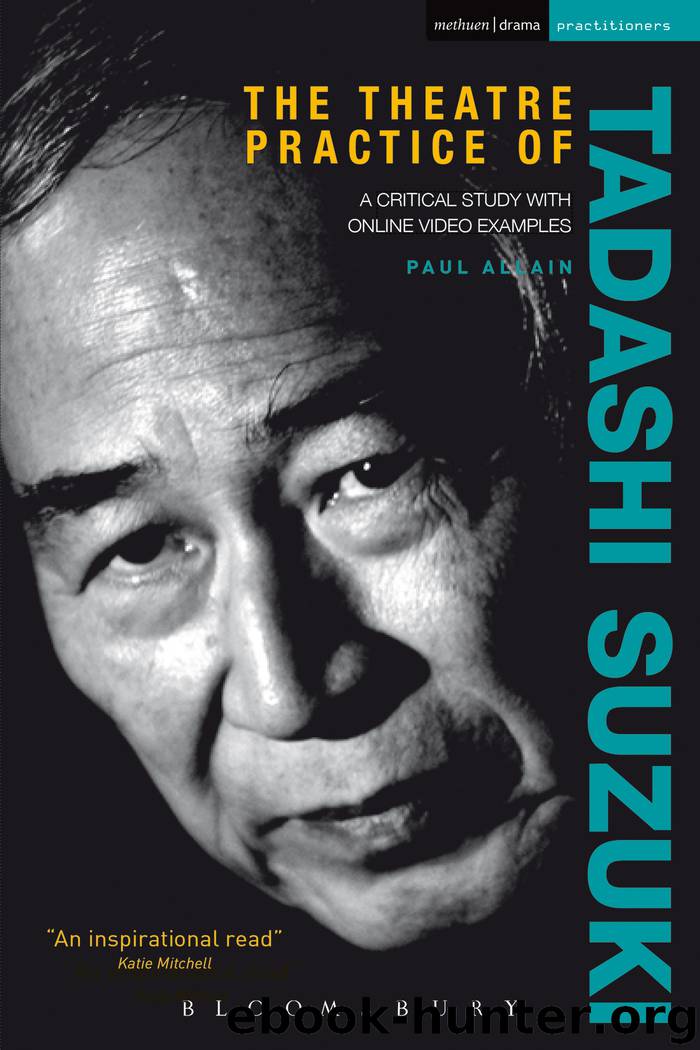The Theatre Practice of Tadashi Suzuki by Paul Allain

Author:Paul Allain
Language: eng
Format: epub
Publisher: Bloomsbury_UK
Published: 2014-03-20T16:00:00+00:00
Slow ten tekka ten
This exercise is in sharp contrast to the fast, exhausting walks and demands mental stamina and focus. You form two evenly spaced staggered lines opposite each other. To music, you then traverse the room at a very slow pace, passing in the middle. The torso must move at a constant tempo and remain level and controlled. The feet must not be separated into the constituent elements of heel–ball–toe, but meet the floor as a unit and also point forwards, as if following tramlines. The sensation created is that the body is being pulled across the space by a thick rope attached to your centre, while being simultaneously tugged back by a lesser tension. This opposition is known as hipparihai in Japanese. It is similar (though on a different axis) to the centring achieved by the upper body pulling up and the lower half pushing down into the ground that is found in noh and other traditional performing arts. At a prescribed time in the ponderous music, you turn, change to another level and return across the space. This turn is always out to and never away from the imagined audience.
There are two difficult shifts of balance in the walk: first, when the foot wants to rush to take the forward-moving torso’s weight; and second, when the torso wants to stop as the weight falls solely on to the back leg. You have to resist and control the forward momentum and then the lack of it in order to maintain an even speed. It is important that the focus is fixed clearly on the horizon and does not become diffused, as can be a tendency. An image that is frequently used in this exercise is the notion that you move the whole space with you as you turn back into the room. You should sustain the projection of your energy forward, imagining what you are moving towards, but with a clear sense of the space behind. Objects and arm positions are added, which are fixed after the turn in a ‘freestyle’ position of your choice. Another variant is that the arms move slowly and constantly at a different rhythm from the rest of the body on the return walk.
Download
This site does not store any files on its server. We only index and link to content provided by other sites. Please contact the content providers to delete copyright contents if any and email us, we'll remove relevant links or contents immediately.
| Acting & Auditioning | Broadway & Musicals |
| Circus | Direction & Production |
| History & Criticism | Miming |
| Playwriting | Puppets & Puppetry |
| Stage Lighting | Stagecraft |
Call Me by Your Name by André Aciman(20371)
Ready Player One by Cline Ernest(14524)
How to Be a Bawse: A Guide to Conquering Life by Lilly Singh(7391)
Wiseguy by Nicholas Pileggi(5671)
The Kite Runner by Khaled Hosseini(5083)
On Writing A Memoir of the Craft by Stephen King(4863)
Audition by Ryu Murakami(4850)
The Crown by Robert Lacey(4723)
Call me by your name by Andre Aciman(4619)
Gerald's Game by Stephen King(4581)
Harry Potter and the Cursed Child: The Journey by Harry Potter Theatrical Productions(4440)
Dialogue by Robert McKee(4321)
The Perils of Being Moderately Famous by Soha Ali Khan(4169)
Dynamic Alignment Through Imagery by Eric Franklin(4116)
Apollo 8 by Jeffrey Kluger(3637)
Seriously... I'm Kidding by Ellen DeGeneres(3577)
The Inner Game of Tennis by W. Timothy Gallwey(3575)
How to be Champion: My Autobiography by Sarah Millican(3555)
Darker by E L James(3477)
